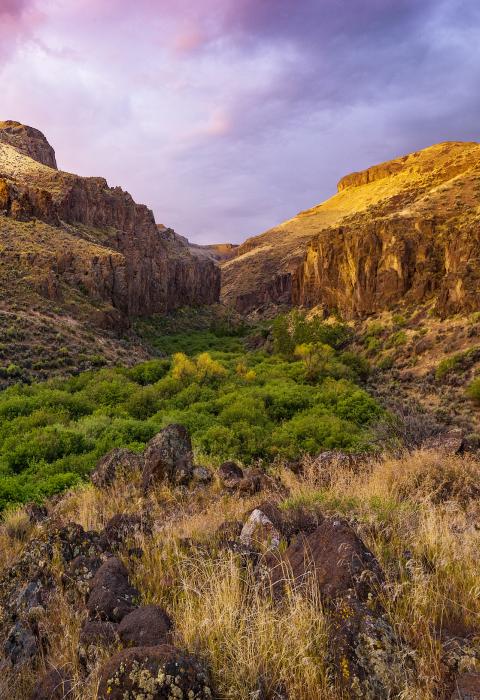Little Jacks Creek
Idaho
Little Jacks Creek is located in the Little Jacks Wilderness and flows through a multi-tiered, 1,000-foot-deep basalt canyon system. The narrow, winding stream provides habitat for redband trout, and the area offers excellent opportunities for viewing wildlife, especially bighorn sheep.
Designated Reach
March 30, 2009. Little Jacks Creek from the downstream boundary of the Little Jacks Creek Wilderness upstream to the mouth of OX Prong Creek.
Outstandingly Remarkable Values
Fish
Little Jacks, Big Jacks, Cottonwood, and Duncan Creeks are among the 17% of desert streams in the Northern Basin and Range identified as aquatic-habitat strongholds for redband trout, a BLM sensitive species and a state of Idaho species of special concern. Little Jacks Creek’s good water quality, a well-shaded riparian vegetative canopy, and long-term protection from livestock grazing have produced the highest densities of redband trout of any surveyed stream in southwest Idaho.
The success of fisheries in these systems depends on appropriate flows during key life stages. These streams exhibit typical flashy, desert streamflows to which the resident fish species are adapted. In summer and early fall, low flows are sufficient to maintain standing pools for fish survival. The high flows that may occur only every few years are integral to the maintenance of channels that support the pool depths and channel diversity and are also necessary for fish survival.
Recreation
Due to its meandering character, diversity of landforms, and topographic screening, Little Dicks Creek offers exceptional opportunities for solitude and for challenging wilderness hiking, wildlife viewing, and photography.
Scenery
Canyons along Little Jacks Creek are dominated by a mixture of high, vertical lines and forms of coarse-textured, red, brown, or blackish eroded cliffs, often glazed with yellow to light green micro-flora. Intertwined with the vertical features are some very steep diagonal lines that frame triangular forms associated with talus slopes. Slopes have a mosaic of medium-textured, yellow and subdued green sagebrush-bunchgrass and/or dark green juniper, and medium-textured, reddish rhyolite rubble fields and/or coarse-textured, blackish basalt rubble fields.
Although basalt and rhyolite canyon/riparian associations are seen in many areas of southwest Idaho, the associations found on Little Jacks Creek and other designated Owyhee, Bruneau, and Jarbidge segments are among the best representations of this landscape in the region.
Wildlife
Little Jacks Creek and surrounding wilderness provide habitat for mountain quail, sage hens, mountain lions, mule deer, pronghorn antelope, bobcats, coyotes, and bighorn sheep. Common large and mid-sized predators in the area include cougars, bobcats, coyotes, badgers, and raccoons. Small mammals include rodents (mice, kangaroo rats, voles, squirrels, and chipmunks), rabbits, shrews, bats, weasels, and skunks.
Songbirds, waterfowl, shorebirds, and raptors are present in the area, as are several snake and lizard species and a few amphibians (frogs, toads, and salamanders).
Little Jacks Creek is included in the area of Preliminary Priority Habitat for greater sage-grouse. Additional Idaho BLM sensitive species include the bald eagle, yellow-billed cuckoo, prairie falcon ferruginous hawk, several neotropical migratory bird species, several bat species, Columbia spotted frog, and western trout. Cliffs support spotted and Townsend’s big-eared bats, both Idaho BLM sensitive species.

